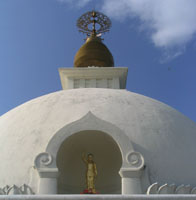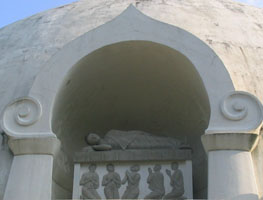Lori A. Snyder
Social Studies Department
Longmeadow High School
Home
The
Peace Stupa
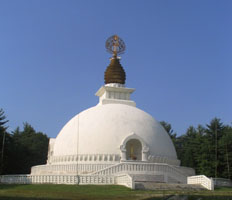 |
Although called a "peace pagoda", this is actually a stupa or Buddhist shrine. Upon the Buddha's death, his cremated remains were divided and distributed among local rulers throughout Northern India. The remains were split into eight portions so that they would be spread in all directions. |
| One of the most distinctive features of the stupa is the umbrella. It is considered to be a symbolic representatin of a buddha mind or enlightenment. |
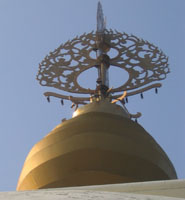 |
|
Another architectural feature of a stupa is the four niches. These alcoves will typically contain statues of the four directional buddhas, Amoghasiddhi (N), Ratnasambhava(S), Akshobhya (E), Amitabha (W). However, this particular stupa does not follow these orthodox positions. Here there is a standing buddha with his right hand raised in the gesture, mudra, of salutation, representing reassurance or freedom from fear. This gesture is common in early Buddhist sculpture. The Japanese inscription below this niche reads, " Widely make offerings to the relics." |
|
One circumabulates a stupa in a clockwise direction. Historically, it was appropriate to make joyful noises, play horns, beat drums, blow horns and celebrate. Worship at stupas became a primary focus of Buddhist ritual activity. These shrines usually enclose sacred objects including such things as the remains of buddhas, saints, revered teachers, objects used by them, and Buddhist texts. |
 |
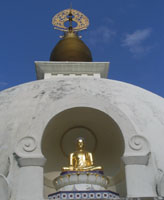 |
As one continues to circumabulate, the next buddha encountered will be a seated buddha whose right hand is touching the earth. This is a very significant gesture in Buddhist iconography. It represents the triumph of Siddartha over Mara, a force associated with desires that lead to samsara or the continuing cycle of rebirth. The Japanese inscription below this niche reads, "This ground of mine is peaceful and secure." |
|
Continuing to circumabulate, the next niche contains a sculptural rendition of the Buddha's "Final Nirvana" (parinirvana). The Buddha laid down on his right side between two trees, his head facing north and died. Usually he is surrounded by followers who react to his death in various ways. The Japanese inscription below this niche reads, "All conditioned activities are impermanent. This is the 'dharma' of origination and cessation. When origination and cessation itself ceases, [This] still quiescence is happiness." |
|
Some other details include a repeating lotus blossom and elephant pattern around the base of the stupa. The lotus flower signifies the attainment of enlightenment just as the blossom is able to grow and bloom out of mud. The elephant is an auspicious symbol as well. Siddartha's mother, Queen Mahamaya dreamt of a visit by a white elephant the night that he was conceived.
|
.
 |
 |
You
will notice other lotus blossom detailing all around the stupa.
Be sure to look for as many variations as you can.
|
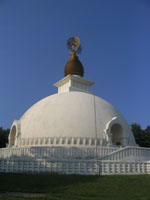 |
Suggested Student Activities: Have
students: A helpful resource on Buddhist Art before you visit would be the slide set titled, "Buddhist Art: A New Perspective "; GSF 003 available from the Five College Center for East Asian Studies, Northampton, MA. A special thanks to fellow NEH participants Heng Shun and Mei-Wang Shao for their assistance in translating the Japanese inscriptions. |
This site was created by Lori A. Snyder at the NEH Summer Institute "Cultures and Religions of the Himalayan Region," held at the College of the Holy Cross, Summer 2004
